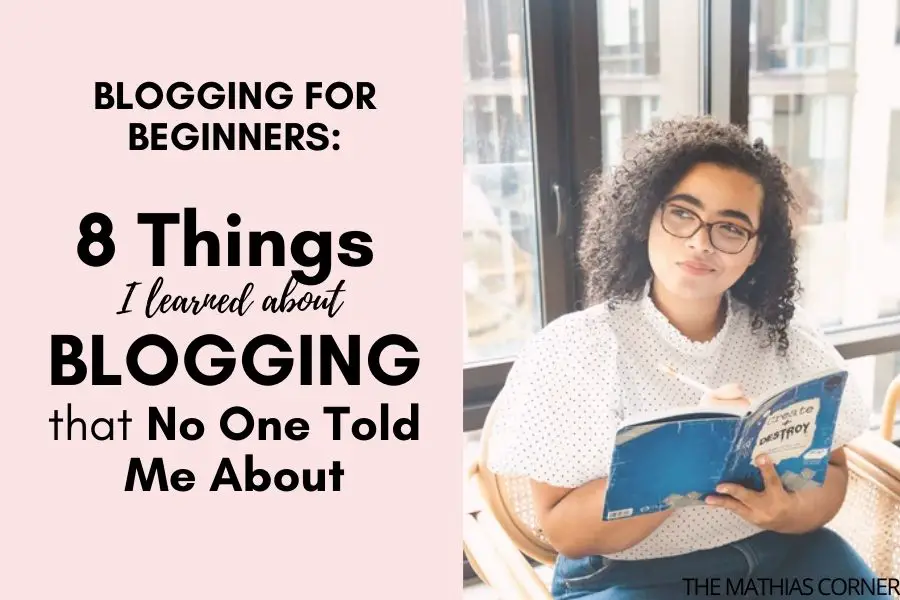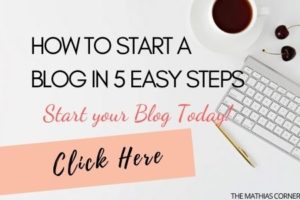I’ve been familiar with blogging since I started publishing on free blogging platforms such as Blogger and WordPress.com. But it’s only in December 2020 that I leaped to web-host my blogs.
I’m currently at the 4-month mark in blogging with a web-hosted blog. As I write this piece, I aim to share with my fellow new bloggers what I didn’t see coming when I started this website.
Just like you, video tutorials and articles about blogging tips for new writers were my only resources.
I was optimistic to start my own blogging website. But when I got the chance to buy my own domain name, a lot of unexpected happenings overwhelmed me that no one from the videos I watched ever told me about.
8 Blogging Tips for New Bloggers that I Learned through Time
So here, I’m going to share with you what I experienced as a new blogger. What struck me, hindered me, and allowed me to push forward.
1. Think twice over your domain name and niche.
New bloggers must have some plan before they buy their domain name and decide on a niche. It doesn’t have to be a specific detailed plan, but at least a sight where this should be going.
I started my self-hosted blogs on a whim because I was too excited. I literally spent less than an hour thinking of a niche. Not a second later, I bought the domain. My niche was about new adults who struggle at work.
At the moment, I was ecstatic. But my hesitations occurred as I progress on content creation. There are some topics that I’d love to write about but don’t fit my niche. “I don’t even like working on 9-to-5 jobs,” I told myself.
So after 3 months, I changed my domain name. This time I’ve thought about it for hours – a domain name that represents what I’m blogging about – helping others with my experiences.
If you’re starting your niche site today, make sure to at least have a sight of its direction. Ask yourself these questions:
- What am I knowledgeable about?
- How will I monetize my blog?
- Is my niche profitable?
- What’s my goal in making this blog?
Have sight of where you want to take your website to avoid the mistakes I did.
2. Don’t exert too much effort on designing your website
If you’re a new blogger, with no budget to hire a website designer, then you probably spent time decorating your website until you’re satisfied. You change the colors and design the logo for hours and days.
I also spent numerous days to decorate my website. Unfortunately, I also took them down and try to design them better.
Harsh truth – the time we spent changing the colors of our website could’ve been used in publishing content.
So for fellow new bloggers, I advise you to just choose a clean theme and don’t play too much with the colors.
Truth is, your first 10 posts won’t even get ranked in Google. In other words, people won’t see it, yet! You don’t need to be conscious of how your website looked when you’re starting.
Focus on the content. Also after writing your first blog post, launch your website right away. Don’t set your website with the “Coming Soon” page. Launch your website as soon as possible so it will have time to age. Google recognizes aged blog posts and quality content, so just put it out there.
3. Write approximately 30 quality blog posts in the first 2 months.

After writing about 5 blog posts, I’ve always wondered when my blogs would rank. I read a blog that said the amount of time before a blog gains organic traffic is 3-6 months. Another thing, domain age matters in SEO, too.
“If domain age matters, then I’ll wait 6 months for my domain name to age before I start publishing again,” I told myself. But this was my worst misconception.
Domain age may play a role, but Google also records the age of your every blog post.
I think this piece of knowledge is quite underrated. But for me, the best advice for new bloggers is to write about 30 quality blog posts in their first 2 months, so after 6 months (more or less), your blogs will all rank simultaneously.
Let’s say, if you publish a blog post in January, then it shall pick up some traffic around July. So if you’re publishing 30 blog posts in January and February, then expect that you have a foundation of posts that would rank after 6 months.
4. Stop looking at the Analytics
Looking at the analytics is so tempting. It’s satisfying to see that a new user visits our website. However, we must realize that since we just started our website, that number is not significant.
I know it’s fun to see 1 or 2 visitors every 3 days. But, dang, if you continue to do this, you lose too much time that should’ve been poured on content writing. Moreover, those 1 or 2 visitors don’t provide significant data to interpret.
So again, exert your efforts on making blog posts. Publish regularly and don’t check your analytics until you have about 30 blog posts that have aged 3 months or more.
5. Don’t monetize your blogs early on.
At first, we can’t monetize our website with display ads from Google Adsense because of some requirements. However, we can apply as an Affiliate to various companies.
So on my first month of blogging, I had a signing up marathon and sleepless nights to become an affiliate to many products.
I tried joining Amazon affiliates, Shareasale, Clickbank, and a lot more. Of course, we want to earn as soon as possible!
However, blogging for beginners requires publishing a considerable amount of content first before nose-diving into any type of monetization.
New websites have very little traffic. Furthermore, new bloggers have little authority and proof of trustworthiness, so people may be hesitant to buy from the website.
Focus your content on helpful information, rather than selling a product.

If you’re too focused on earning from affiliate programs, the tendencies are you will make blog posts that circles on promoting, rather than helping. It will look spammy and can turn off a potential buyer. If they find no value in your content, and you just keep on being too salesy, then it drives your audience further.
So when we make content, it should always be for the purpose of helping people. This method will drive many trusting audiences because you’re someone who’s willing to help rather than a salesman trying to brush products on them.
Set a good ratio between helpful posts and product-focused posts
Maybe you can make a ratio of 70-30. 70% of your blog posts must aim to help an audience and the other 30% can be product posts that are meant to promote a product.
Recently, I’ve decreased my focus on placing affiliate links on my website. When there’s a chance, I do add my links, but as of now, I’m more focused on publishing helpful content.
Amazon even warned me that my account with them will be terminated after 90 days if no sales will be registered.
Maybe, I’ll just let it expire and I’ll just make a new Affiliate account when I had more traffic. In the first place, it was the wrong move to monetize a blog with a new website that has very little traffic. I’m now more focused on writing blog posts first.
Fun fact: I got recently approved by Google Adsense. To be honest, it won’t really earn anything unless I have thousands of views per month. But I like putting it to break apart the big blocks of text. Strategic!
Edit: I’m currently in my 9th month. Found out there’s an ad monetization better than Google Adsense. Ezoic!
It increased my ad revenue 12x more than Google Adsense. Plus, you can apply with a minimum of zero traffic.
6. Your images must at least be 15kb to 200kb.
I loved using free images from Unsplash. However, these images are really big in size. My website drastically slowed down prior to this post so I have to find where the problem lies.
We can use Pingdom to check the page speed of our website. But upon manually counting each second, my website loads after 6 seconds and that’s not only slow, that’s a snail! (No offense to all the snails.)
I found out my images were around 1-2 MB each which was really HUGE.
I edit my images on Canva. I resized the images smaller, technically 800 by 300 px or smaller. When I download the images, I make sure it’s in .jpeg format rather than .png. And voilà! My pictures cut about 80% of the file size. Now, my images range between 15 to 100 kb, and my website started to load faster again.
7. 30% Learning from other bloggers, 70% Apply it to yourself

Here’s another blogging tip that we should all remember. I suggest that you still remain watching tutorials and reading blogs from those who have already gone through the process.
- Learn about SEO, what really works and what doesn’t
- Recognize different techniques to write a blog post
- How to effectively present chunks of information to your readers.
In short, we still have a long way to go and we must keep ourselves updated in this industry.
After gathering knowledge, you have to act on it. Apply what you’ve learned.
I’ve had the chance to apply what I learned from other bloggers, then evaluate what works for me and not. Oftentimes, I misinterpret what I learned, and didn’t help me at all, but I was happy to learn the better way from experiencing it first hand.
It’s the same way with everyone else. We must try new approaches and learn through our own experiences.
8. Your posts aren’t all about you; write blogs that help and answer the reader’s questions
I’ve heard many bloggers say, “don’t write a post that YOU want, rather publish one that readers will search for.”
But I say you can do both. Just like this blog post, for example. I’m pumped up to teach what I learned as a new blogger, but I write it in a way that’s “not too much of me”.
It’s about my experience, but it’s aimed to help my readers.
For example, instead of writing “Why I Love Books”, instead, you can write it from the reader’s point of view. “Why n% of the Population Love Reading Books.” There, it becomes more consumable to readers.
Also, in a blog post, avoid writing too much about yourself if the topic doesn’t require it. People don’t usually take an interest in your story unless it’s a valuable example of what you’re trying to imply.
Wrapping up
So far, these are what I’ve learned from my early stages of blogging. There are many things you can learn from other people, but there’s a bunch you can learn from experiencing it yourself.
Blogging for beginners is easy if you are willing to experience the ups and downs of it. Be willing to accept change, act on what you’ve learned, and be patient because results will eventually come.
God bless us on our journey. Happy Blogging!
My Blogging Recommendations to Help Grow your Blog!
Grammarly – Detects misspelled words and grammatical errors. Moreover, it gives your piece an overall performance score based on correctness, clarity, engagement, and the delivery of your blog!
Bluehost – Bluehost has been the best web hosting as of today. Competitive prices, yet they commit to superb speed, and reliable servers.
Ezoic – Aside from ad monetization, Ezoic also offers SEO, Analytics, and Site Speed tools. With Ezoic, my ad revenue increased 12x more than Google Adsense. Thankfully, they now offer an Access Now Program that accepts new bloggers with a minimum of zero – again – zero traffic!
Was this helpful? If you’d like to support my work, you can buy me a coffee at Ko-fi! Thank you! 🙂
You may also like:



